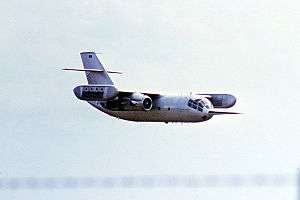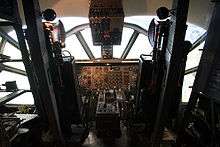Dornier Do 31
| Do 31 | |
|---|---|
 | |
| Dornier Do 31 in 1968 | |
| Role | VTOL transport |
| Manufacturer | Dornier Flugzeugwerke |
| First flight | 10 February 1967 |
| Status | Project cancelled April 1970 |
| Primary user | German Air Force |
| Number built | 3 |
|
| |
The Dornier Do 31 was a West German experimental VTOL jet transport built by Dornier. The Do 31 was designed to meet a NATO specification (NBMR-4) for a tactical support aircraft for the EWR VJ 101 VTOL strike aircraft designed under the NATO contract of BMR-3.[1] The project was cancelled in 1970 owing to high costs, technical problems and a change of requirement.
Design and development
In the early 1960s, the German Air Force became increasingly concerned that its airfields were vulnerable to air attack from Eastern Bloc forces and actively researched the possibility of dispersed operations which included flying from Autobahnen but required aircraft with STOVL capabilities. Part of these trials involved the modification of German F-104 Starfighters to be rocket-launched from stationary ramps in what became known as the ZELL program. The Starfighters were to be recovered to short strips using aircraft carrier-type arresting gear. The Do 31 was intended to use the same strips as forward operating bases.[2]
When the high cost, technical and logistical difficulties were realized, the German Air Force ceased trials involving VTOL aircraft such as the Do 31, VJ101, and the later VFW VAK 191B which resulted in the cancellation of these projects and further use of these aircraft was limited to research purposes only.
Initial designs incorporated a Bristol Pegasus[note 1] vectored-thrust turbofan in each of the two inboard nacelles and four Rolls-Royce RB162 lift engines in each of the outer nacelles. It was planned to dispense with the outer nacelles and their engines when larger RB153 turbofans (of approximately 5,000 lbf (22 kN) thrust) became available. By mounting the engines in pods, the fuselage could provide a capacious hold with a rear loading ramp.
In all, three test prototypes were built, these being E1, E2 and E3 - the "E" indicating Experimentell (Experimental). E1 was powered only by the Pegasus engines, and was designed to test horizontal flight. E2 was a static test airframe, and did not fly. E3 had both Pegasus and RB162 lift engines installed, and was designed to test the vertical flight mode. The first prototype (E1) first flew on 10 February 1967 with just the two Pegasus engines. The third prototype (E3) flew in July 1967 with all ten engines fitted. The first hovering flight took place on 22 November 1967. Full forward and backward transitions were made in December 1967.
The Do 31 established several Fédération Aéronautique Internationale (FAI) world records during its ferry flight to the 1969 Paris Air Show.[3][4][5][6][7]
It was the first, and so far only, vertical takeoff jet transport ever built. The project was cancelled in April 1970, although it made its final public flight on 4 May 1970 during the ILA in Hanover. One of the factors that led to the cancellation was the large drag and weight of the lift engine pods which reduced the useful payload and range compared to conventional transport aircraft.
To cope with the complex and fast computations necessary for vertical takeoff, the Do 31 was equipped with a Dornier DO-960 hybrid computer.
Survivors

Both flying prototypes have been preserved in Germany, the fate and current location of the non-flying testbed (E2) is not known.
- Dornier Do 31 E1, D-9530, is preserved and displayed at the Dornier Museum Friedrichshafen.[8]
- Dornier Do 31 E3, D-9531, was initially put into storage at Oberpfaffenhofen, then for several years on display in the open in the courtyard of the Deutsches Museum in Munich and after restoration is now on display at the Deutsches Museum Flugwerft Schleissheim at Oberschleissheim near Munich[9]
Operators

- German Air Force (Luftwaffe)
Specifications (Do 31E)

Data from "The Observers Book of Aircraft"[10]
General characteristics
- Crew: two
- Capacity: 36 troops or 24 casualty stretchers
- Length: 20.53 m (67 ft 4 in)
- Wingspan: 18 m (59 ft 3 in)
- Height: 8.53 m (28 ft)
- Wing area: 57 m² (613.56 ft²)
- Useful load: 3,500 kg (7,715 lb)
- Loaded weight: 22,453 kg (49,500 lb)
- Max. takeoff weight: 27,422 kg (60,500 lb)
- Powerplant:
- 2 × Rolls-Royce Pegasus BE.53/2 turbofan, 68.95 kN (15,500 lbf) each
- 8 × Rolls-Royce RB162-4D Vertically mounted turbojet lift engines, 19.57 kN (4,400 lbf) each
Performance
- Maximum speed: 730 km/h (452 mph)
- Cruise speed: 650 km/h (404 mph)
- Range: 1,800 km (1,120 mi) with maximum payload
- Service ceiling: 10,700 m (35,100 ft)
- Rate of climb: 19.2 m/s (3,780 ft/min) -using Pegasus engines only
See also
- Aircraft of comparable role, configuration and era
- Related lists
Notes
- ↑ By the time of the first flight, Rolls-Royce had taken over Bristol Engines.
References
Citations
- ↑ Jackson, 1976. p. 143.
- ↑ Jackson, 1976. p.29.
- ↑ "FAI Record ID #5536 - Speed over a recognized course, München - Paris. Class H (VTOL aircraft)" Fédération Aéronautique Internationale Record date 27 May 1969. Accessed: 4 October 2015.
- ↑ "FAI Record ID #15153 - Speed, München - Paris. Class H (VTOL aircraft)" Fédération Aéronautique Internationale Record date 27 May 1969. Accessed: 4 October 2015.
- ↑ "FAI Record ID #15151 - Altitude, München - Paris. Class H (VTOL aircraft)" Fédération Aéronautique Internationale Record date 27 May 1969. Accessed: 4 October 2015.
- ↑ "FAI Record ID #15152 - Duration, München - Paris. Class H (VTOL aircraft)" Fédération Aéronautique Internationale Record date 27 May 1969. Accessed: 4 October 2015.
- ↑ "FAI Record ID #6370 - Distance, München - Paris. Class H (VTOL aircraft)" Fédération Aéronautique Internationale Record date 27 May 1969. Accessed: 4 October 2015.
- ↑ Dornier Museum press release (German language) Retrieved: 9 August 2009
- ↑ Deutsches Museum, Do 31 www.deutsches-museum.de Retrieved: 5 April 2010
- ↑ Green, 1968. p. 88.
Bibliography
- Green, William. The Observer's Book of Aircraft. London. Frederick Warne & Co. Ltd., 1968.
- Jackson, Paul A. German Military Aviation 1956–1976. Hinckley, Leicestershire, UK: Midland Counties Publications, 1976. ISBN 0-904597-03-2.
External links
| Wikimedia Commons has media related to Dornier Do 31. |